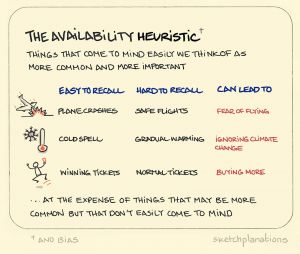Heuristics: Difference between revisions
No edit summary |
|||
| Line 1: | Line 1: | ||
A heuristic is a mental shortcut intended by evolution to lower the usage of brain power whilst still achieving the same approximate result. | A heuristic is a mental shortcut intended by evolution to lower the usage of brain power whilst still achieving the same approximate result. | ||
== Anchoring == | |||
A famous and very common heuristic is called the ‘Anchoring effect’. This suggests that the first piece of information we get is weighed much more heavily in our decision making process than subsequent pieces of information – regardless of their actual relative importance. You might know this as ‘first impressions’. | |||
== Availability == | == Availability == | ||
[[File:Availability heuristic.jpg|alt=Availability heuristic|thumb|Things that are easier to remember become mor e important.]] | [[File:Availability heuristic.jpg|alt=Availability heuristic|thumb|Things that are easier to remember become mor e important.]] | ||
| Line 12: | Line 14: | ||
== Affect == | == Affect == | ||
The affect heuristic involves making choices that are influenced by the emotions that an individual is experiencing at that moment. For example, research has shown that people are more likely to see decisions as having benefits and lower risks when they are in a positive mood. Negative emotions, on the other hand, lead people to focus on the potential downsides of a decision rather than the possible benefits.4 | The affect heuristic involves making choices that are influenced by the emotions that an individual is experiencing at that moment. For example, research has shown that people are more likely to see decisions as having benefits and lower risks when they are in a positive mood. Negative emotions, on the other hand, lead people to focus on the potential downsides of a decision rather than the possible benefits.4 | ||
Revision as of 06:11, 17 April 2022
A heuristic is a mental shortcut intended by evolution to lower the usage of brain power whilst still achieving the same approximate result.
Anchoring
A famous and very common heuristic is called the ‘Anchoring effect’. This suggests that the first piece of information we get is weighed much more heavily in our decision making process than subsequent pieces of information – regardless of their actual relative importance. You might know this as ‘first impressions’.
Availability
The availability heuristic (closely related to the frequency illusion) involves making decisions based upon how easy it is to bring something to mind. When you are trying to make a decision, you might quickly remember a number of relevant examples. Since these are more readily available in your memory, you will likely judge these outcomes as being more common or frequently occurring.
For example, if you are thinking of flying and suddenly think of a number of recent airline accidents, you might feel like air travel is too dangerous and decide to travel by car instead. Because those examples of air disasters came to mind so easily, the availability heuristic leads you to think that plane crashes are more common than they really are.
Representativeness
The representativeness heuristic involves making a decision by comparing the present situation to the most representative mental prototype. When you are trying to decide if someone is trustworthy, you might compare aspects of the individual to other mental examples you hold. A sweet older woman might remind you of your grandmother, so you might immediately assume that she is kind, gentle, and trustworthy.
Affect
The affect heuristic involves making choices that are influenced by the emotions that an individual is experiencing at that moment. For example, research has shown that people are more likely to see decisions as having benefits and lower risks when they are in a positive mood. Negative emotions, on the other hand, lead people to focus on the potential downsides of a decision rather than the possible benefits.4
